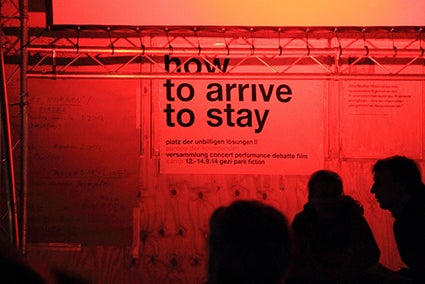Follow the author on Twitter:
@DasMaitreyi

Want to learn more about urban migration and social inclusion? Watch live discussion on March 11 at 12:30pm EST. I just finished reading
Doug Saunders’
Arrival City – a fascinating book about cities as the fountains of development and dynamism. This portrayal isn’t by any means new, but Doug brings today’s cities alive, with stories of migrants who come from overseas or from villages. Every city has its distinctive pattern, every informal settlement its own history.
Doug’s vivid account took me back to my hometown, Jaipur, Rajasthan, India: a city better known as a romantic tourist destination than as an “arrival city”. But there it is. A city that by most accounts, is very livable (perhaps that’s why angst against the city is low and it isn’t written about quite as much), and is host to thousands of migrants of all ilk.
Of the many that have over years begun to call Jaipur home, are families from Cooch Behar district in West Bengal. The bottom line is that women from Cooch Behar are overwhelmingly domestic workers in Jaipur homes. Why? For two reasons. First, Jaipur suddenly grew from being a mid-sized city in the 1990s to a thriving metropolis, up there among top ten Indian cities, by 2011, with a huge demand for domestic labor.
Second, taboos and norms (which would have to be a whole other discussion) make local Rajasthani women reluctant to work in the homes of others. Strangely, it’s fine to work in others’ fields or on construction sites, but not in others’ homes. So, it is difficult for the rich and the growing middle class to find local women to work in their homes. I forgot to say that domestic workers are overwhelmingly women, in case anyone was wondering.
Why Cooch Behar: a district way out at the other end of the country? That’s a story of social networks that establish migration patterns. Jaipur was a princely state and the Maharaja married the princess of Cooch Behar – the famed Gayatri Devi, in whose entourage came the first set of ladies-in-waiting. Over time, this migration route solidified and fulfilled Jaipur’s demand for female domestic workers. Some micro studies show that almost half of all female domestic workers in Jaipur come from Cooch Behar.
The connection with the royal family gave female domestic workers from Cooch Behar a respectability they would not have got otherwise. They were migrants; they spoke a different language, ate different food and had distinct customs. Over time, their increasing numbers have allowed them solidarity that affords safety in jobs that are unsafe and informal. As time has passed, these women and their families have set up their own “bastis” (perhaps the right Western term is “slums”, yet the term “basti” signifies habitation and doesn’t have the same depressing connotation as does “slum”). They have created “little Cooch Behars” in many parts of the city – where the language is a dialect of Bengali, and where groceries come all the way from West Bengal, thus fueling a thriving trade.
This reminds me of Alejandro Portes’ postulation of “ ethnic enclaves”, where migrants skirt discrimination by establishing enclaves and growing self-employed ventures. As an aside, connections with the royal family (which are long since blurred in reality, yet remain strong in the local narrative of both original residents and migrants) have allowed Cooch Behari men, the husbands of domestic workers, into jobs like masonry and carpentry, which they learned in their home towns.
So, is this a sweet little fairy tale? Absolutely not! As numbers of Cooch Beharis rise in Jaipur and as they become socially and economically more mobile, there are conflicts with those who consider themselves native Rajasthani. Second, let’s not forget that we are talking about domestic servants – women at or near the bottom of the totem pole, with little bargaining power and subject to difficult working conditions.
So, to oversimplify, the growth of Cooch Behari female domestic workers in Jaipur is a story of migration, led by networks, solidified by enclaves and sustained by the grit and agency of these women.
Come join my conversation with Doug Saunders on how the World Bank can collaborate with national and local governments to realize the benefits of labor mobility by fostering social inclusion in the world’s “arrival cities.” This will be on March 11 at 12.30 EDT and you can join live here.

Want to learn more about urban migration and social inclusion? Watch live discussion on March 11 at 12:30pm EST.
Doug’s vivid account took me back to my hometown, Jaipur, Rajasthan, India: a city better known as a romantic tourist destination than as an “arrival city”. But there it is. A city that by most accounts, is very livable (perhaps that’s why angst against the city is low and it isn’t written about quite as much), and is host to thousands of migrants of all ilk.
Of the many that have over years begun to call Jaipur home, are families from Cooch Behar district in West Bengal. The bottom line is that women from Cooch Behar are overwhelmingly domestic workers in Jaipur homes. Why? For two reasons. First, Jaipur suddenly grew from being a mid-sized city in the 1990s to a thriving metropolis, up there among top ten Indian cities, by 2011, with a huge demand for domestic labor.
Second, taboos and norms (which would have to be a whole other discussion) make local Rajasthani women reluctant to work in the homes of others. Strangely, it’s fine to work in others’ fields or on construction sites, but not in others’ homes. So, it is difficult for the rich and the growing middle class to find local women to work in their homes. I forgot to say that domestic workers are overwhelmingly women, in case anyone was wondering.
Why Cooch Behar: a district way out at the other end of the country? That’s a story of social networks that establish migration patterns. Jaipur was a princely state and the Maharaja married the princess of Cooch Behar – the famed Gayatri Devi, in whose entourage came the first set of ladies-in-waiting. Over time, this migration route solidified and fulfilled Jaipur’s demand for female domestic workers. Some micro studies show that almost half of all female domestic workers in Jaipur come from Cooch Behar.
The connection with the royal family gave female domestic workers from Cooch Behar a respectability they would not have got otherwise. They were migrants; they spoke a different language, ate different food and had distinct customs. Over time, their increasing numbers have allowed them solidarity that affords safety in jobs that are unsafe and informal. As time has passed, these women and their families have set up their own “bastis” (perhaps the right Western term is “slums”, yet the term “basti” signifies habitation and doesn’t have the same depressing connotation as does “slum”). They have created “little Cooch Behars” in many parts of the city – where the language is a dialect of Bengali, and where groceries come all the way from West Bengal, thus fueling a thriving trade.
This reminds me of Alejandro Portes’ postulation of “ ethnic enclaves”, where migrants skirt discrimination by establishing enclaves and growing self-employed ventures. As an aside, connections with the royal family (which are long since blurred in reality, yet remain strong in the local narrative of both original residents and migrants) have allowed Cooch Behari men, the husbands of domestic workers, into jobs like masonry and carpentry, which they learned in their home towns.
So, is this a sweet little fairy tale? Absolutely not! As numbers of Cooch Beharis rise in Jaipur and as they become socially and economically more mobile, there are conflicts with those who consider themselves native Rajasthani. Second, let’s not forget that we are talking about domestic servants – women at or near the bottom of the totem pole, with little bargaining power and subject to difficult working conditions.
So, to oversimplify, the growth of Cooch Behari female domestic workers in Jaipur is a story of migration, led by networks, solidified by enclaves and sustained by the grit and agency of these women.
Come join my conversation with Doug Saunders on how the World Bank can collaborate with national and local governments to realize the benefits of labor mobility by fostering social inclusion in the world’s “arrival cities.” This will be on March 11 at 12.30 EDT and you can join live here.


Join the Conversation